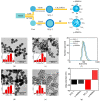A Comprehensive Study of Drug Loading in Hollow Mesoporous Silica Nanoparticles: Impacting Factors and Loading Efficiency
- PMID: 34069019
- PMCID: PMC8156057
- DOI: 10.3390/nano11051293
A Comprehensive Study of Drug Loading in Hollow Mesoporous Silica Nanoparticles: Impacting Factors and Loading Efficiency
Abstract
Although hollow mesoporous silica nanoparticles (HMSNs) have been intensively studied as nanocarriers, selecting the right HMSNs for specific drugs still remains challenging due to the enormous diversity in so far reported HMSNs and drugs. To this end, we herein made a comprehensive study on drug loading in HMSNs from the viewpoint of impacting factors and loading efficiency. Specifically, two types of HMSNs with negative and positive zeta potential were delicately constructed, and three categories of drugs were selected as delivery targets: highly hydrophobic and lipophobic (oily), hydrophobic, and hydrophilic. The results indicated that (i) oily drugs could be efficiently loaded into both of the two HMSNs, (ii) HMSNs were not good carriers for hydrophobic drugs, especially for planar drugs, (iii) HMSNs had high loading efficiency towards oppositely charged hydrophilic drugs, i.e., negatively charged HMSNs for cationic molecules and vice versa, (iv) entrapped drugs would alter zeta potential of drug-loaded HMSNs. This work may provide general guidelines about designing high-payload HMSNs by reference to the physicochemical property of drugs.
Keywords: cavity diameter; hollow mesoporous silica nanoparticle; loading efficiency; pore size; zeta potential.
Conflict of interest statement
The authors declare no conflict of interest.
Figures








Similar articles
-
Novel scheme for rapid synthesis of hollow mesoporous silica nanoparticles (HMSNs) and their application as an efficient delivery carrier for oral bioavailability improvement of poorly water-soluble BCS type II drugs.Colloids Surf B Biointerfaces. 2019 Apr 1;176:185-193. doi: 10.1016/j.colsurfb.2019.01.004. Epub 2019 Jan 2. Colloids Surf B Biointerfaces. 2019. PMID: 30616109
-
Improved Gene Transfer with Functionalized Hollow Mesoporous Silica Nanoparticles of Reduced Cytotoxicity.Materials (Basel). 2017 Jun 30;10(7):731. doi: 10.3390/ma10070731. Materials (Basel). 2017. PMID: 28773087 Free PMC article.
-
Construction of homogenous/heterogeneous hollow mesoporous silica nanostructures by silica-etching chemistry: principles, synthesis, and applications.Acc Chem Res. 2014 Jan 21;47(1):125-37. doi: 10.1021/ar400091e. Epub 2013 Aug 14. Acc Chem Res. 2014. PMID: 23944328
-
Hollow Mesoporous Silica Nanoparticles with Tunable Structures for Controlled Drug Delivery.ACS Appl Mater Interfaces. 2017 Jan 25;9(3):2123-2129. doi: 10.1021/acsami.6b13876. Epub 2017 Jan 9. ACS Appl Mater Interfaces. 2017. PMID: 28004570
-
Cetyltrimethylammonium bromide in the synthesis of mesoporous silica nanoparticles: General aspects and in vitro toxicity.Adv Colloid Interface Sci. 2022 Sep;307:102746. doi: 10.1016/j.cis.2022.102746. Epub 2022 Jul 23. Adv Colloid Interface Sci. 2022. PMID: 35969965 Review.
Cited by
-
Silver-Sulfamethazine-Conjugated β-Cyclodextrin/Dextran-Coated Magnetic Nanoparticles for Pathogen Inhibition.Nanomaterials (Basel). 2024 Feb 17;14(4):371. doi: 10.3390/nano14040371. Nanomaterials (Basel). 2024. PMID: 38392744 Free PMC article.
References
-
- Agrawal M., Saraf S., Saraf S., Dubey S.K., Puri A., Patel R.J., Ajazuddin, Ravichandiran V., Murty U.S., Alexander A. Recent strategies and advances in the fabrication of nano lipid carriers and their application towards brain targeting. J. Control. Release. 2020;321:372–415. doi: 10.1016/j.jconrel.2020.02.020. - DOI - PubMed
Grants and funding
LinkOut - more resources
Full Text Sources

